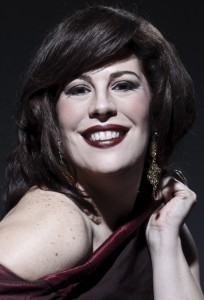April, 12, 2012. Roy Thomson Hall.
When the music is thrilling it is impossible to be unhappy.
 So it was at the Toronto Symphony last night: Gianandrea Noseda conducted the orchestra and diva extraordinaire Sondra Radvanovksy through a program of Verdi and Tchaikovsky from which peak after peak of pleasures unfolded like a succession of Alpine views.
So it was at the Toronto Symphony last night: Gianandrea Noseda conducted the orchestra and diva extraordinaire Sondra Radvanovksy through a program of Verdi and Tchaikovsky from which peak after peak of pleasures unfolded like a succession of Alpine views.
Noseda has the power to shape phrases and the spaces around them so that you hear music as if for the first time. He also has a magic touch that allows minor details to be outstanding without disturbing the flow of performance. For instance there is the astonishing clarity of the three trombones in the dramatic opening of Verdi’s “Overture to I vespri siciliani.” Another instance is Joseph Johnson’s brief cello solo in Verdi’s “Ballet Music from Macbeth.” Johnson’s tone had a fleshy smoothness, as if from the throat of a saxophone. Noseda on the podium appears infused with a sensuous life that is infectious.
 For Ms. Radvanovsky’s debut with her hometown orchestra, she chose to open with Elena’s bolero from I vespri siciliani. Her plush sound soars above the orchestra, performing a finely nuanced dive into softness so detailed it takes your breath away, and her vibrato establishes a mood of excitement that abides. Her second aria, from Tchaikovsky’s Eugene Onegin is Tatanya’s nakedly passionate plea for the love and understanding of Onegin. Ms. Radvanovsky showed impeccable security in transiting the highs and lows as she rises from a naive, trembling frame of mind, to a magnificence of passion that sounded as if Callas and Sutherland were co-inhabiting her body, inspiring the truth and saturation of her colours.
For Ms. Radvanovsky’s debut with her hometown orchestra, she chose to open with Elena’s bolero from I vespri siciliani. Her plush sound soars above the orchestra, performing a finely nuanced dive into softness so detailed it takes your breath away, and her vibrato establishes a mood of excitement that abides. Her second aria, from Tchaikovsky’s Eugene Onegin is Tatanya’s nakedly passionate plea for the love and understanding of Onegin. Ms. Radvanovsky showed impeccable security in transiting the highs and lows as she rises from a naive, trembling frame of mind, to a magnificence of passion that sounded as if Callas and Sutherland were co-inhabiting her body, inspiring the truth and saturation of her colours.
She treated the nearly hysterical audience to an encore—“Spring Waters,” by Sergei Rachmaninov, which she performed in a way that brought to mind Pavarotti’s phrase that the voice that lives inside a singer is a wild beast—trained, but nonetheless, wild.
Noseda exhibited Tchaikovsky’s Symphony No. 6 in B Minor, Op. 74 “Pathetique” as a long poetic tableau. The opening “adagio” is a faint stirring as of dead leaves that roll mournfully out into prolonged lament until the flutes begin to teach leafy misery to dance. Waves of melody begin to roll like mist up into the sun, bringing solace, repeated in variations led by the principal flute, oboe and clarinet—Valdepeñas’ clarinet reaching deliciously down into healing chalumeau register.
The “Allegro con grazia” follows with the sweeping, light-footed rhythms of a waltz that for a period sweeps away cares until they return in the third movement, scattering the gathered serenity, trampling soft pleasures under the boots of a brutal march. The Finale’s mood drops to leaden movement and lamentation; a flood of pathos drowns senses and brings a paralytic sensation that dissolves only at the sound of the closing gong in whose dying reverberations Noseda holds the audience within the longest imaginable silence before he unclenches and allows tentative applause followed by the entire audience rising from their seats, as if one person, for a solid, standing ovation.
Treat yourself to the repeat performance, this Saturday. If not, look for it on CBC Radio 2′s In Concert on Sunday, May 20.
Please leave you comments HERE
